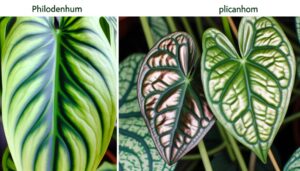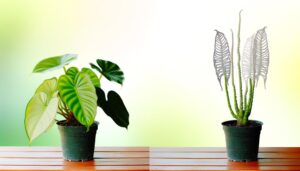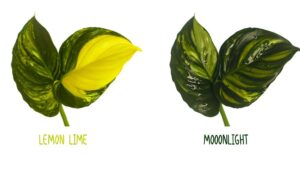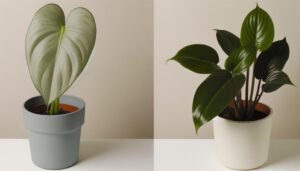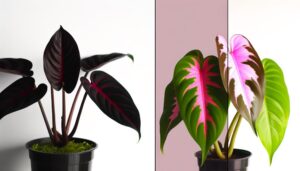Philodendron Deja Vu Vs Hope: Choosing the Right One!
Philodendron ‘Deja Vu’ and Philodendron ‘Hope’ display contrasting morphological characteristics. ‘Deja Vu’ features shiny, fern-like leaves up to 45 cm, perfect for small spaces with its upright growth and shorter internodes.
Conversely, ‘Hope’ has larger, wavy leaves up to 90 cm with a dull finish, and a sprawling, bushy habit, facilitated by longer internodes and numerous aerial roots. Both thrive in bright, indirect light and prefer well-draining, nutrient-rich soil.
They exhibit differing aesthetics, making careful selection essential for specific horticultural applications. To fully understand their nuanced care requirements and best growing conditions, one must explore further.
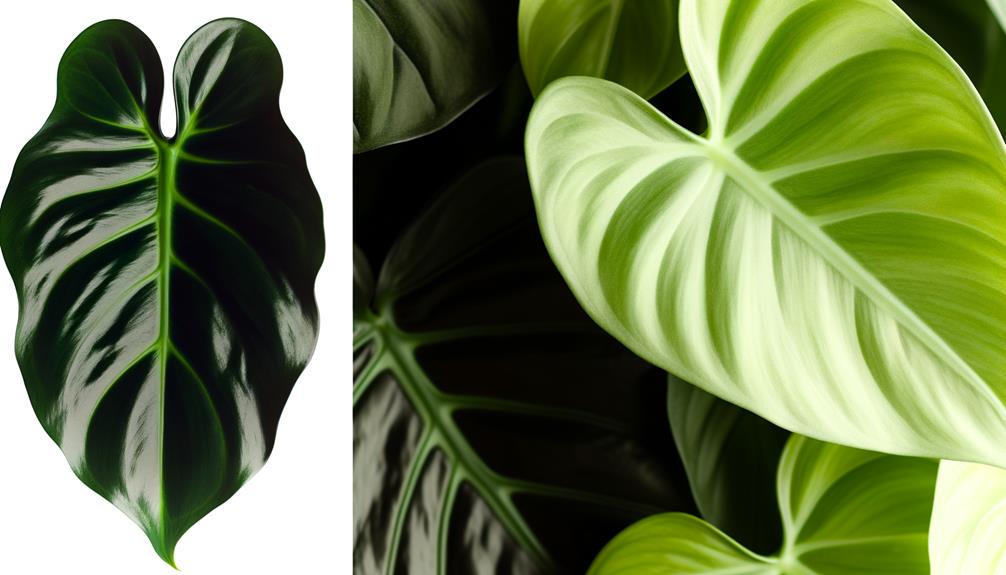
Comparison of Philodendron Deja Vu and Philodendron Hope
| Feature | Philodendron Deja Vu | Philodendron Hope |
|---|---|---|
| Scientific Name | Philodendron sp. ‘Deja Vu’ | Thaumatophyllum bipinnatifidum (formerly Philodendron selloum) |
| Leaf Texture | Smooth, glossy | Smooth, glossy |
| Leaf Shape | Deeply serrated, frilly edges | Deeply lobed, less frilly |
| Leaf Color | Dark green | Dark green |
| Growth Habit | Upright, compact | Upright, spreading |
| Mature Size | Medium-sized | Larger, can grow quite large |
| Light Preference | Bright, indirect light | Bright, indirect light |
| Watering Needs | Moderate, allow topsoil to dry between waterings | Moderate, allow topsoil to dry between waterings |
| Temperature Tolerance | Prefers warmer temperatures | Prefers warmer temperatures |
| Humidity Preference | Moderate to high | Moderate to high |
| Common Uses | Indoor houseplant, decorative | Indoor houseplant, decorative |
Leaf Structure
The leaf structure of Philodendron ‘Deja Vu’ (Philodendron bipinnatifidum) is characterized by deeply lobed, pinnatifid leaves with a glossy surface, while Philodendron ‘Hope’ (Philodendron selloum) exhibits broad, wavy-margined leaves with a more pronounced undulate texture.
The former’s leaves are intricately divided, presenting a feather-like appearance, and measuring up to 45 cm in length. The glossy surface enhances light reflection, contributing to its ornamental value.
In contrast, the latter’s leaves are considerably wider, with undulating edges that create a rippled effect. These leaves can reach dimensions up to 90 cm in length and exhibit a matte finish.
The differential morphology between these two cultivars underscores their adaptability and distinct aesthetic contributions to botanical collections.
Growth Habit
In addition to their distinct leaf structures, Philodendron ‘Deja Vu’ and Philodendron ‘Hope’ exhibit varied growth habits that further differentiate them within the genus.
Philodendron ‘Deja Vu’ (Philodendron bipinnatifidum ‘Deja Vu’) manifests a compact, upright growth pattern, making it suitable for limited spaces.
Conversely, Philodendron ‘Hope’ (Philodendron bipinnatifidum ‘Hope’) displays a more sprawling, bushy habit, expanding both horizontally and vertically.
This divergence in growth habits can be categorized as follows:
Philodendron ‘Deja Vu’:
- Compact and upright
- Ideal for confined spaces
Philodendron ‘Hope’:
- Sprawling and bushy
- Expands horizontally and vertically
Stem Structure:
- ‘Deja Vu’: Shorter internodes
- ‘Hope’: Longer internodes
Aerial Roots:
- ‘Deja Vu’: Fewer aerial roots
- ‘Hope’: Numerous aerial roots
Light Requirements
Philodendron ‘Deja Vu’ and Philodendron ‘Hope’ both thrive in bright, indirect light, although their tolerance to varying light conditions can influence their growth and foliage characteristics.
Philodendron bipinnatifidum ‘Deja Vu’ prefers consistent exposure to filtered sunlight, which promotes its deeply lobed, glossy leaves. Insufficient light may result in leggy growth and diminished leaf size.
Conversely, Philodendron bipinnatifidum ‘Hope’ exhibits more resilience in lower light environments but achieves peak growth under similar bright, indirect conditions. Extended exposure to direct sunlight can cause leaf burn in both species, necessitating careful placement.
For maximum photosynthetic efficiency and healthy development, a light level of approximately 10,000 to 20,000 lux is ideal. Monitoring light exposure ensures strong foliage and overall plant vigor.
Watering Needs
Maintaining ideal soil moisture is essential for the health and growth of both Philodendron bipinnatifidum ‘Deja Vu’ and Philodendron bipinnatifidum ‘Hope’. These tropical plants require consistent but moderate watering to thrive. Overwatering or underwatering can lead to root rot or dehydration, respectively.
To achieve peak hydration:
- Frequency: Water when the top 1-2 inches of soil feel dry to the touch.
- Method: Use room-temperature water and ensure uniform distribution around the root zone.
- Drainage: Always use pots with drainage holes to prevent waterlogging.
- Seasonal Adjustment: Reduce watering frequency during winter months when the plant’s growth rate slows.
Soil Preferences
Both Philodendron bipinnatifidum ‘Deja Vu’ and Philodendron bipinnatifidum ‘Hope’ thrive in well-draining, nutrient-rich potting mixes that mimic their natural tropical habitat. Ideal soils consist of a combination of peat moss, perlite, and pine bark, which guarantees adequate aeration and moisture retention without becoming waterlogged.
These substrates provide a balanced pH range of 5.5 to 6.5, best for nutrient uptake. Organic matter such as compost or worm castings enhances soil fertility, promoting robust root development. Additionally, these philodendrons benefit from a substrate that maintains consistent moisture levels while preventing root rot, a common issue in poorly draining soils.
Proper soil composition is essential for sustaining their vigorous growth and health, reflecting their epiphytic and terrestrial adaptations.
Fertilization
To support the vigorous growth and health of Philodendron bipinnatifidum ‘Deja Vu’ and Philodendron bipinnatifidum ‘Hope’, an appropriate fertilization regimen is crucial. These tropical epiphytes thrive with a balanced nutrient supply.
Key recommendations for optimal fertilization include:
- Use a balanced fertilizer: A formulation with an N-P-K ratio of 10-10-10 or 20-20-20 guarantees an even supply of nitrogen, phosphorus, and potassium.
- Frequency: Fertilize bi-monthly during the growing season (spring and summer) to support active growth.
- Dilution: Apply fertilizer at half the recommended strength to avoid nutrient burn and guarantee gradual nutrient absorption.
- Organic options: Utilize slow-release organic fertilizers or compost to provide a steady nutrient influx, enhancing soil microbiome health.
These practices guarantee robust development and leaf well-being.
Temperature Tolerance
Philodendron bipinnatifidum ‘Deja Vu’ and Philodendron bipinnatifidum ‘Hope’ exhibit peak growth at temperatures ranging between 65°F and 80°F (18°C to 27°C). These temperature conditions are ideal for maintaining cellular function, enzyme activity, and overall metabolic processes.
Both cultivars demonstrate a tolerance for minor temperature fluctuations but may exhibit stress symptoms if exposed to temperatures below 55°F (13°C) or above 85°F (29°C) for prolonged periods. Cold stress can result in chlorosis and stunted growth, while excessive heat may cause wilting and reduced photosynthetic efficiency.
Ensuring a stable temperature range is essential for sustaining optimal physiological activities and preventing thermal stress, thereby promoting robust growth and health in both ‘Deja Vu’ and ‘Hope’ philodendrons.
Humidity Needs
Maintaining an ideal moisture level is equally important as temperature regulation for the healthy growth of Philodendron bipinnatifidum ‘Deja Vu’ and Philodendron bipinnatifidum ‘Hope’.
These species thrive in environments with increased moisture levels, ideally ranging between 60% and 80%. Inadequate moisture can lead to subpar growth and heightened susceptibility to pests and diseases.
To ensure peak moisture, consider the following:
- Humidifiers: Utilize an electric humidifier to maintain consistent moisture levels in the air.
- Misting: Regularly mist the foliage to replicate their natural tropical habitat.
- Pebble Trays: Place the pots on trays filled with water and pebbles to boost ambient moisture.
- Grouping: Position multiple plants together to create a microenvironment with higher moisture.
These methods will notably enhance plant health and vigor.
Pruning Tips
Pruning Philodendron bipinnatifidum ‘Deja Vu’ and Philodendron bipinnatifidum ‘Hope’ is essential for maintaining their structural integrity and promoting robust growth. Regular pruning prevents overcrowding, reduces pest infestations, and encourages healthy foliage development.
Utilize sterilized pruning shears to avoid disease transmission. Trim dead or yellowing leaves at the base and remove any leggy, overgrown stems to maintain an aesthetically pleasing shape.
| Pruning Aspect | Best Practice |
|---|---|
| Timing | Early spring or post-bloom |
| Tools | Sterilized pruning shears |
| Technique | Cut at the base of the stem |
| Frequency | Every 2-3 months |
Pruning should be conducted with precision to avoid damaging the plant’s vascular system.
Propagation Methods
Propagation of Philodendron ‘Deja Vu’ and Philodendron bipinnatifidum ‘Hope’ primarily involves stem cutting techniques, requiring precise excision of healthy nodes.
The soil and water conditions necessary for best root development are critical, with specific moisture levels and substrate compositions influencing success rates.
Comparative analysis of rooting timeframes reveals variations in the pace of root emergence and establishment, contingent on the species’ physiological responses to environmental conditions.
Stem Cutting Techniques
To propagate Philodendron Deja Vu (Philodendron bipinnatifidum) and Philodendron Hope (Philodendron selloum), begin by selecting a healthy stem with at least one node and a few leaves, ensuring ideal conditions for root development.
Proper stem cutting techniques are essential for successful propagation:
- Sterilize Tools: Use sterilized pruning shears to prevent pathogen transfer.
- Make the Cut: Slice just below a node, at a 45-degree angle to maximize surface area.
- Remove Lower Leaves: Strip the lower leaves to avoid submerging them in water, which can cause rot.
- Apply Rooting Hormone: Dip the cut end in a rooting hormone to expedite root formation.
Implementing these steps will enhance the likelihood of successful propagation, ensuring robust growth in subsequent stages.
Soil and Water Requirements
For ideal propagation of Philodendron bipinnatifidum and Philodendron selloum, precise soil and water conditions are essential to encourage healthy root development and plant growth. A well-draining, aerated soil medium composed of peat, perlite, and pine bark is recommended to prevent waterlogging and root rot. The best pH range is between 5.5 to 6.5, facilitating nutrient uptake.
Consistent moisture is important; hence, the medium should remain moderately moist but not saturated. Watering should be done using distilled or rainwater to avoid mineral buildup. During propagation, maintaining humidity levels around 70-80% enhances root initiation. Employing a humidity dome or misting can achieve this.
Adequate light, preferably indirect and bright, supports photosynthesis, promoting faster root establishment.
Rooting Timeframes Comparison
Understanding the best soil and water conditions sets the stage for a detailed examination of the rooting timeframes associated with different propagation methods for Philodendron bipinnatifidum and Philodendron selloum. Both species exhibit distinct rooting periods contingent upon the chosen propagation technique.
- Stem Cuttings in Soil: Typically, *P. bipinnatifidum* requires 4-6 weeks, while *P. selloum* may take 6-8 weeks to establish roots.
- Water Propagation: *P. bipinnatifidum* roots within 3-4 weeks, whereas *P. selloum* takes approximately 4-5 weeks.
- Air Layering: This method sees *P. bipinnatifidum* rooting in 6-8 weeks compared to 8-10 weeks for *P. selloum*.
- Leaf-Bud Cuttings: Both species necessitate about 5-7 weeks for root development.
These timeframes are influenced by environmental factors such as humidity, temperature, and light.
Common Pests
Both Philodendron Deja Vu and Philodendron Hope are susceptible to common pests such as aphids (Aphididae), spider mites (Tetranychidae), and mealybugs (Pseudococcidae). These pests can cause significant damage by feeding on the plant’s sap, leading to weakened growth, yellowing leaves, and potential plant death. Effective pest management requires regular inspection and immediate intervention.
| Pest Type | Symptoms and Damage |
|---|---|
| Aphids | Yellowing leaves, stunted growth |
| Spider Mites | Webbing, speckled leaves |
| Mealybugs | Cotton-like masses, leaf drop |
| Scale Insects | Hard, dome-shaped bodies on stems |
| Thrips | Silvery streaks, distorted leaves |
Utilizing integrated pest management (IPM) strategies, including biological control, chemical treatments, and cultural practices, can effectively mitigate these pests. Regular monitoring is important for early detection and control.
Conclusion
In comparing Philodendron ‘Deja Vu’ and Philodendron bipinnatifidum ‘Hope,’ it becomes apparent that each exhibits unique characteristics in leaf morphology, growth patterns, and environmental preferences.
When choosing between these species, one must consider specific horticultural needs and aesthetic goals.
By understanding their distinct requirements and behaviors, a gardener can cultivate a thriving plant collection.
Ultimately, selecting the appropriate philodendron is akin to finding a needle in a haystack, necessitating careful scrutiny and informed decision-making.

